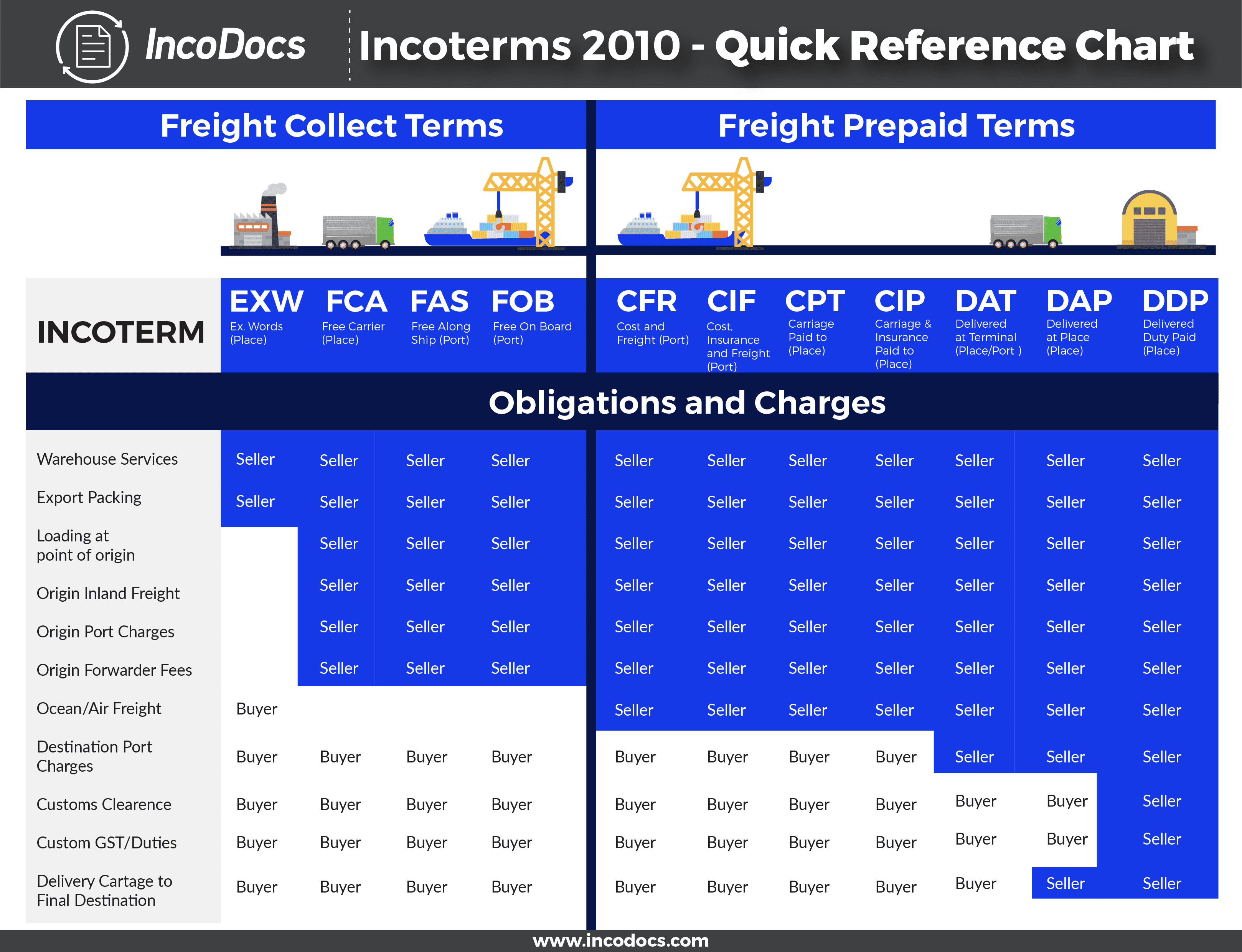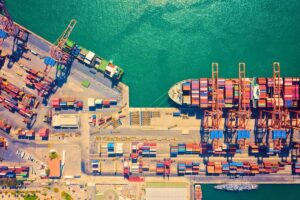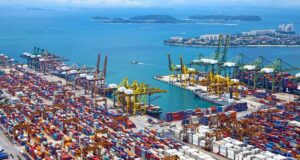Please note the ICC have published updates to Incoterms®:
Click here to read the current article on current Incoterms®2020
Incoterms® play such a vital part in global trade. Incoterms® 2010 or Incoterms® 2018 can seem to be confusing at first. But, buyers and sellers must clearly understand how they work and their obligations along the supply chain. In this article we provide simple explanations along with an Incoterms® infographic to explain Incoterms®.
What are Incoterms®?
To put it simply, Incoterms® are the selling terms that the buyer and seller of goods both agree to during international transactions. These rules are accepted by governments and legal authorities around the world. Understanding Incoterms® is a vital part of International Trade because they clearly state which tasks, costs and risks are associated with the buyer and the seller. The Incoterm® states when the seller’s costs and risks are transferred onto the buyer. It is also important to understand that not all rules apply in all cases. Some encompass any mode or modes of transport (this category includes FCA, CPT, CIP, DAT, DAP and DDP). Whereas others only apply for sea and inland waterway transport (FAS, FOB, CFR and CIF), which we explain below.
Why are Incoterms® vital in International Trade?
Incoterms® are referred to as International Commercial Terms. They are a set of rules published by the International Chamber of Commerce (ICC), which relate to International Commercial Law. According to the ICC, Incoterms® rules provide internationally accepted definitions and rules of interpretation for most common commercial terms used in contracts for the sale of goods’. All International purchases will be processed on an agreed Incoterm® to define which party legally incurs costs and risks. Incoterms® will be clearly stated on relevant shipping documents.
Please note the ICC have published updates to Incoterms®:
Click here to read the current article on current Incoterms®2020
Other Incoterms® Explained
FCA – Free Carrier
- The seller delivers the goods to the carrier or another person nominated by the buyer at the seller’s premises or another named place.
- The parties are well advised to specify as explicitly as possible the point within the named place of delivery, as the risk passes to the buyer at that point.
CPT – Carriage Paid To
- The seller delivers the goods to the carrier or another person nominated by the seller at an agreed place (if any such site is agreed between parties).
- The seller must contract for and pay the costs of carriage necessary to bring the goods to the named place of destination.
CIP – Carriage And Insurance Paid To
- The seller has the same responsibilities as CPT, but they also contract for insurance cover against the buyer’s risk of loss of or damage to the goods during the carriage.
- The buyer should note that under CIP the seller is required to obtain insurance only on minimum cover. Should the buyer wish to have more insurance protection, it will need either to agree as much expressly with the seller or to make its own extra insurance arrangements.
DAT – Delivered At Terminal
- The seller delivers when the goods, once unloaded from the arriving means of transport, are placed at the disposal of the buyer at a named terminal at the designated port or place of destination. “Terminal” includes a place, whether covered or not, such as a quay, warehouse, container yard or road, rail or air cargo terminal.
- The seller bears all risks involved in bringing the goods to and unloading them at the terminal at the named port or place of destination.
DAP – Delivered At Place
- The seller delivers when the goods are placed at the disposal of the buyer on the arriving means of transport ready for unloading at the named place of destination.
- The seller bears all risks involved in bringing the goods to the named place.
DDP – Delivered Duty Paid
- The seller delivers the goods when the goods are placed at the disposal of the buyer, cleared for import on the arriving means of transport ready for unloading at the named place of destination.
- The seller bears all the costs and risks involved in bringing the goods to the place of destination. They must clear the products not only for export but also for import, to pay any duty for both export and import and to carry out all customs formalities.
Other Rules for Sea and Inland waterway transport.
FAS – Free Alongside Ship
- The seller delivers when the goods are placed alongside the vessel (e.g., on a quay or a barge) nominated by the buyer at the named port of shipment.
- The risk of loss of or damage to the goods passes when the products are alongside the ship. The buyer bears all costs from that moment onwards.
CIF – Cost, Insurance and Freight
- The seller delivers the goods on board the vessel or procures the goods already so delivered. The risk of loss of or damage to the goods passes when the products are on the ship.
- The seller must contract for and pay the costs and freight necessary to bring the goods to the named port of destination.
- The seller also contracts for insurance cover against the buyer’s risk of loss of or damage to the goods during the carriage.
- The buyer should note that under CIF the seller is required to obtain insurance only on minimum cover. Should the buyer wish to have more insurance protection, it will need either to agree as much expressly with the seller or to make its own extra insurance arrangements.
Are you involved in Global Trade?
Our team created IncoDocs to make global trade easy. We allow Importers and Exporters in over 100 countries to streamline their shipping document process. Try it for yourself today. If you need more information speak to one of our trade specialists, we will be happy to answer any of your questions.







